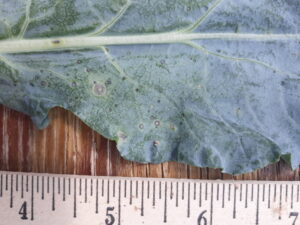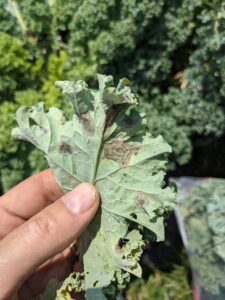Late last season, I observed Alternaria leaf spot on kale. I want to use this article to review this disease on all brassica crops. This disease also occurs on broccoli, cabbage and other leafy brassicas. Alternaria leafspot usually doesn’t cause yield loss, but can cause unmarketable leaves.
The symptoms on leaves usually include round, dark lesions with target-like rings (Figure 1 and 2). Lesions can also occur on stems. In either case, the lesions may cause the leaf to become unmarketable. Lesions may grow together when the disease is severe.
Alternaria leaf spot is caused by a fungus that produces spores (known as conidia) that may spread with rain/wind. The fungus may survive in crop residue, such as infected leaves, and overwinter in that way. When the crop residue has completely rotted, the fungus will quickly die. To infect a leaf, Alternaria needs leaf moisture caused by rain or dew. The optimum temperature depends on what species of fungus is present. A. brassicae requires temperature from 64-75 °F; A. brassicicola requires 68-86 °F.
Tomato growers may recognize the name Alternaria and the target-like lesions. Early blight lesions are caused by a cousin of the fungi described here. However, the fungi described here will not affect tomato; nor will the early blight pathogen affect brassicas.
Black rot of cabbage, broccoli and other brassica crops has symptoms that are different including ‘V’ shaped lesions along the margin of the leaf. There is an article about black rot of brassica crops in this issue of the Hotline.
The fungus that causes Alternaria leaf spot of crucifer crops may survive on seed; purchase seed tested for the disease and be careful saving seed. Hot water soaks of 122 °F for 20 min may help to eliminate the pathogen. Be sure to rotate crucifer crops and use fall tillage to disperse crop residue. A search of the Midwest Vegetable Production Guide reveals several fungicides that should be helpful in reducing the severity of this disease.
It is probably too early to be observing symptoms of Alternaria leaf spot of crucifer crops. However, it will be wise to familiarize yourself with the symptoms and the management options.

